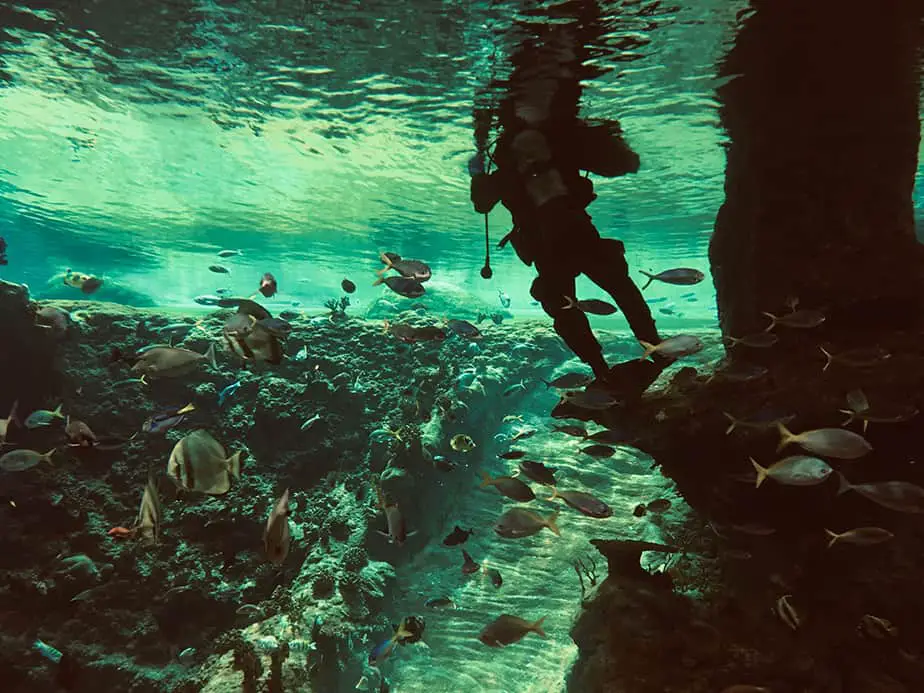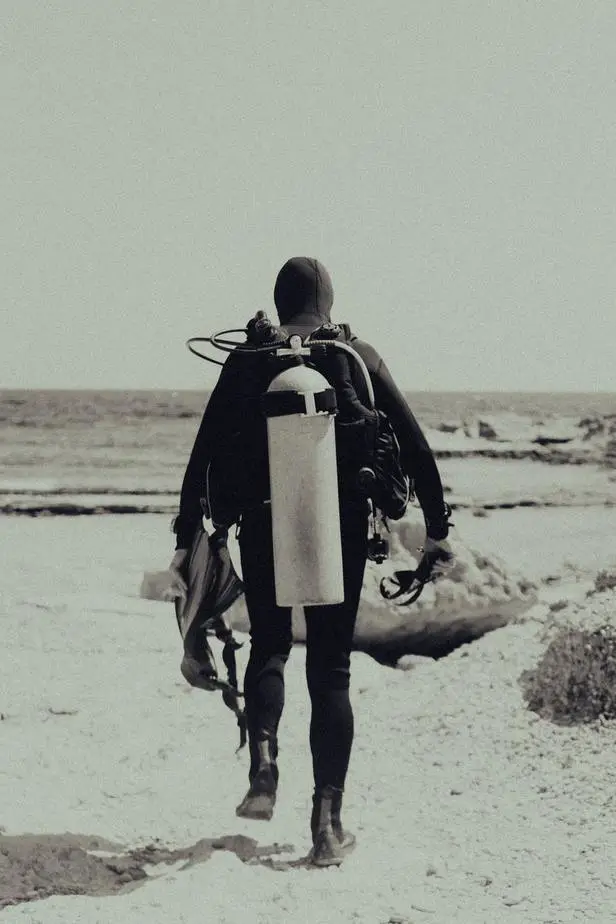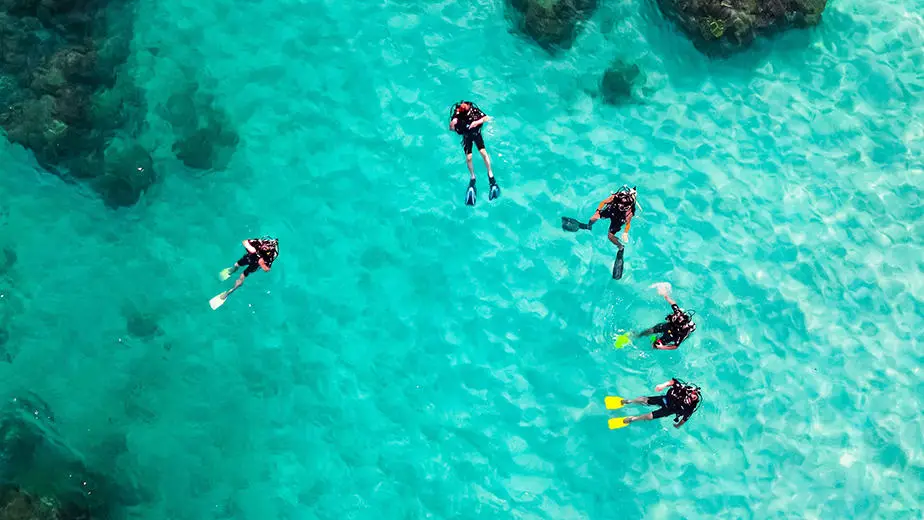Shore diving or beach diving is a type of diving where you forgo the boat and dive directly from the shore instead. It offers a slightly different experience, however it has its perks. For starters, there is plenty to see right by the coast, so depending on where you dive you don’t necessarily need to charter a boat to take you to a specific dive spot.
Furthermore, many people enjoy the freedom and autonomy that shore diving offers. You are no longer at the whim of your boat operator, and can do all of the preparation yourself. With that said, it’s important to understand that beach diving is more than just donning your scuba gear, wading into the water, and swimming off. In this article, we’ll discuss more about shore diving, what you should do to prepare, and some tips for staying safe.
Why are the benefits of shore diving?
One of the top reasons for shore diving is so enticing is that you and your dive buddies have free reign to plan and enjoy your own self-guided dives. You decide the location, whether it is an inland, freshwater quarry, or beach site. By checking the weather report, you can plan for when the conditions for your dive are optimal.
You can also decide on the time where you can avoid large crowds of people. At the dive site, you decide on the depth and length of your dive. Additionally, those who are prone to seasickness will be thankful that they don’t have to sit on a rocking boat. Instead, you can drive to these destinations and you just need to swim some distance out to access the optimal dive sites.
Depending on the location, it’s possible that the shallow ocean floor by the coast will suddenly give way to a massive abyss filled with plenty of marine and plant life. In other words, you don’t need to swim very far or take a boat to experience plenty of what the underwater world offers. Last but not least, shore diving is a very cost-effective way for you to enjoy scuba diving on your own terms.
Where can you shore dive?
You can technically shore dive anywhere you have access to a large body of water. However, you may be disappointed to find that not all places have interesting things to see or do. Furthermore, many inland dive sites, such as quarries and lakes, are privately owned. Some coastal areas are public spaces but they may be located in places where there are privately-owned homes, businesses, or in a state or national park.
When you plan a shore dive, it’s crucial that you do it legally and respectfully. If you want to shore dive from a private site, for instance, you might need to pay an entrance fee or get a permit. You might need to present proof that you are a certified diver, have insurance, sign a liability waiver, and agree to the owner’s rules of operation.
Even when you are on a public site, you should be respectful to nearby homeowners. Make sure you park in a public space, clean up any mess you make, cover up when donning and doffing your wetsuit, and keep noise down to a minimum.
If you’re thinking about diving within the United States, the best shore diving spots in Florida are sure to blow you expectations out of the water. If you’re thinking about diving abroad, make sure that your travel insurance covers scuba diving and snorkeling, because if you read the fine print, you’ll realize not all of them do.
Plan your dive

Since you’re not diving with a group, as independent divers, you and your dive buddies must do all of the preparations for your dive trip. We recommend planning days in advance, because last minute plans are almost sure to go awry.
Discuss potential dive sites, factoring in how accessible it is and if shore diving is permitted. Create a checklist of all the scuba gear you need and plan out what the dive objective is. Also include items you’ll need for the base camp.
Just because you’re diving on your own doesn’t mean you can’t consult with other divers at the closest dive center. After all, you’re probably headed there anyway to fill your scuba tank, rent gear, and for any other purchases you might need such as extra dive weights or a diver down flag.
Ask the locals for tips
Whenever you’re heading out to a new dive site, there is no harm in asking the locals for advice. At the dive center, you might as well ask the employees for some local tips and tricks on your planned shore diving site. Chances are, they have exclusive knowledge as well as maps or charts to share.
Divers are a friendly and helpful bunch. They can give you a heads up on entry and exit areas, best parking spots, and what to avoid. If this is your first time at the dive site, getting the inside scoop like this is invaluable.
It’s good to check websites and apps for the day’s weather patterns and tidal variations, but again, you can also ask a local for the most current information. How you choose the dive site also depends on what your dive objectives are, like seeing some particular marine wildlife or shipwreck.
Once you’re at the dive site, you can check with other divers for more information on the area (if you haven’t asked at a dive center or have more questions). Some questions you might want to ask are: Does the underwater terrain have sharp or slippery rocks? Is the bottom silty or muddy? How is the visibility that day? Are there any pitfalls you should avoid?
We recommend arriving at the dive site early so that you can check the surroundings before gearing up and entering. Keep an eye out for kayakers, boaters, or jet skiers in the vicinity. Also watch out for kitesurfers, parasailers, and SUP boarders. You do not want to collide with any of them.
Also observe environmental changes like rip currents. It’s possible that, after monitoring the area, you decide there are too many challenges for you to safely dive. Hopefully you have a plan B.
Set up a base camp
Once you’ve decided that the site is suitable for diving, it’s time to set up a base camp. Look for a spot that doesn’t obstruct foot traffic and try to be considerate of others wherever you set up. You can use a large tarp spread on the ground or even just your car as the base camp.
Cars work well if the parking spot is close enough to the dive site. You can gear up in the car, safely stow your personal items, and lock everything in the car before heading out. Place your key(s) in a dry pouch secured in a wetsuit pocket before starting your dive.
A simple tarp spread on the ground is adequate if you have a friend on guard duty while you’re diving. Make sure to set the tarp at a location above the high water line. Place the dive gear along the edges of the tarp so you can gear up without getting sand or debris all over the tarp. Hold the tarp down by setting weights or other heavy items on each corner.
Keep the base camp stocked with anything you might need. A first-aid kit, reef-safe sunscreen, fully charged cell phones, emergency contact information, and so forth. You should also bring sufficient snacks and fluids, particularly water, to re-hydrate and refuel during surface intervals. Also bring spare parts or any maintenance gear in case you have a gear malfunction.
Entry and exit points
After you’ve set up the base camp, it’s nearly time to dive. Next up, you should determine the best entry and exit points. You may already have a good idea from asking around or from researching online. Or you can simply come up with a plan right now. Also figure out an alternate exit point in case weather conditions change the course of your dive.
Gearing up for a shore dive
When donning scuba gear for a shore dive, don everything except the mask, snorkel, and fins. If you use open-feel fins, you can don the dive boots but do not wear the fins yet. If you typically wear full foot fins, consider wearing a thin pair of neoprene socks to give your feet extra grip and protect it from debris. This will make it safer for you to walk to and from the water.
Next, help one another gear up and perform a pre-dive equipment inspection. Make sure the tank is turned all the way on, the dive computer has sufficient battery life, and that you have important accessories like your compass, surface marker buoy and line.
Entering the water from the shore

Finally, it is time to head into the water. The reason why we ask you not to wear your mask, snorkel, and fins yet is because, unlike a boat dive where you can just dive right in, you’re going to have to walk a small distance to the water to shore dive. This distance might not seem like much, but when you’re carrying 40 pounds of scuba gear, it can actually prove to be quite tough.
We recommend wearing dive booties or neoprene socks to protect your feet during this walk. We do NOT recommend wearing your fins because they are a major tripping hazard. If you do try to walk with your fins, shuffle backwards to reduce the chances of tripping over the fin blades. What most divers do, if the weather condition allows, is to first walk into chest-deep water, don their mask and snorkel, fully inflate the buoyancy control device (BCD), and then don the fins.
Have your dive buddy support you as you put on one fin at a time. Now provide the same assistance to your dive buddy. If the water conditions are a bit rough, you might have to don the fins by the water’s edge. Take turns steadying each other. If you fall, you’ll feel like a turtle that’s fallen on its shell. Once the fins are on, shuffle backwards or do a sideways crab walk until you’re in deep enough water to start swimming.
Reaching the dive site
You may have to swim a fair distance before you reach the dive site. If so, make sure you fully inflate your BCD so you do not need to spend energy trying to stay afloat. You also might want to use your snorkel instead of your regulator to conserve gas supply. Plot the compass heading in the direction of the site and reverse it on the way back. You can also rely on natural navigation such as any landmarks or following along a wall for more points of reference.
Always keep a close watch on your remaining gas supply. Plan your dive so that you have sufficient gas for your return to the exit area. Most divers begin their ascent when their SPG reads 50 bar or 500 PSI. You can also plan your dive in “thirds” – use ⅓ of the tank for the outbound trip, a third for the return, and a third in reserve just in case.
Shore diving may require one to leave more gas in reserve because the diver has to swim back on their own, or possibly give their buddy air in the event of an emergency. As such, shore diving is optimal when the waters are mild. Rough surf with turbulent waves make it difficult to swim by the surface. If the water conditions are rougher than expected, consider using a dock or stairs to enter or exit.
By knowing how to shore dive, you give yourself more freedom to dive wherever and whenever you want in the future. No longer do you have to charter a boat if you don’t want to, and this can save you a lot of money in the long run. The pre-dive planning required can also be quite enjoyable since you have total control of where to go and when. Just remember to stay cautious, follow the safety procedures, ask the locals for tips, and enjoy how liberating it is to dive from the shore.

